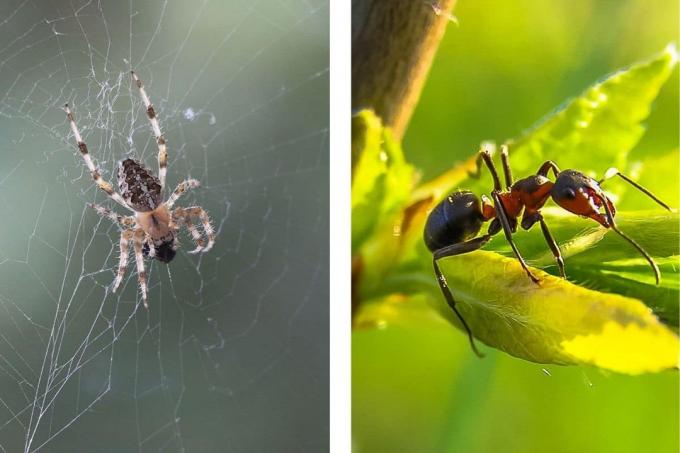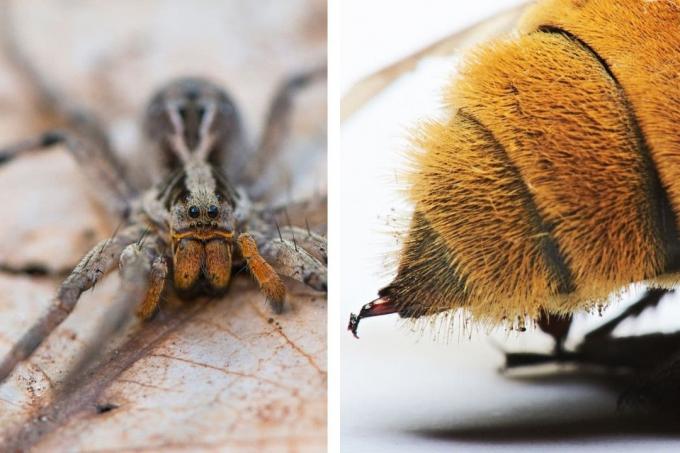
table of contents
- Classification
- anatomy
- Spinnerets
- Poison
- frequently asked Questions
Spiders are often mistaken for insects. You can find out here why this is not the case, where the differences lie primarily in appearance and to which two classes arachnids and insects belong.
In a nutshell
- optical differences easily recognizable
- Distinguish spider and insect based on the number of legs
- Assign arachnids to their own category
Classification
Although spiders and insects belong to the stem group of arthropods (Arthropoda), they have their own classification: arachnids (Arachnida) and insects (Insecta). The different appearance of different anatomical areas of the body is of particular importance for this.

anatomy
The clearest distinguishing marks between insects and Spider species lie in the physique or certain details of their appearance - which ultimately make them two different groups of animals.
Limbs:
Insects belong to the sub-tribe of the six-footed (Hexapoda) and accordingly only have six legs, while the spider usually has eight legs. In addition, the legs of the latter consist of seven limbs - insect legs only have five limbs per limb. Arachnids are also wingless and have no antennae. Arachnids can have other characteristics:
- usually much longer legs
- both front legs more flexible because they work similarly to insect antennae
- partly good jumping ability

Anatomy:
The spider body is made up of two body sections: the front and the rear body part. An insect, on the other hand, always has three body sections, in addition to the front and back, the chest area is clearly recognizable.
Eyes:
A closer look at the eye area reveals some differences between spiders and insects:
- eight individual eyes in arachnids - small reticulated / compound eyes in insect animals
- Spider with main and secondary eyes - Insectas only main eyes
- better visual quality for spiders, because separate image and motion detection (therefore usually faster escape reaction)

Note: Did you know that there is also a spider without eyes? This is the giant crab spider (Sparassidae), which was first discovered in 2012. The chance of encountering this in Europe, however, is very small, as it is so far only native to Laos and lives there in complete darkness in caves.
Spinnerets
Every insect completely lacks the ability to produce silk threads / cobwebs. These produce arachnids through what are known as spinnerets, which are located on their rear ends. With these they catch their prey in a completely different way than insects. Above all, arachnids target the insect for their food intake. In addition, they use the spinnerets to construct the cocoons for their offspring.
Poison
While the insect uses a sting to secrete poison when attacked or to defend itself, the so-called chelicerae take over this function in the spider. They are also called "jaw feelers" because they are in the mouth. These are movable claw tools with which they can bite their prey and at the same time inject poison into it. Those who keep poisonous spiders in the house usually acquire specimens with the poison glands removed. The claws are indispensable for life because they use them to “snap” their food.

Note: Well over 80,000 different Arachnida species are known worldwide. However, more detailed information based on research is only available for about 41,000 species.
frequently asked Questions
When you mean chemical insect repellants, they usually work against spiders as well. However, for environmental reasons and for the sake of your health, you should not use them. There are several home remedies that can help against both types of arthropod. It is best to use fragrances that they dispel. A vinegar-water mixture for spraying is ideal for this purpose.
Yes, because arachnids make an enormous contribution to maintaining the natural balance. They are also considered ideal predators for numerous insect pests, such as aphids.
As with insects, there are species of spider that overwinter in different ways. Some are active in winter and others become frozen in a sheltered winter quarters.



